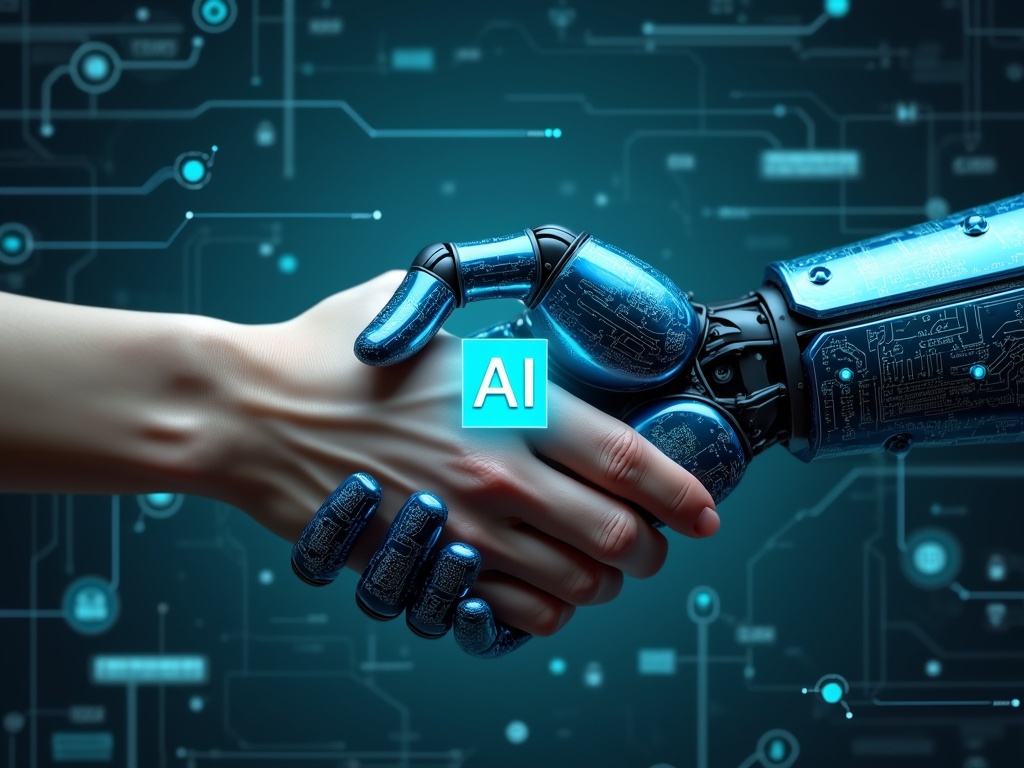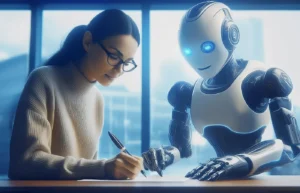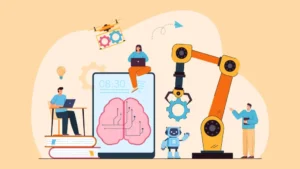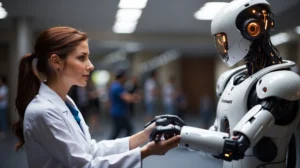Human-AI Collaboration & Robotics: Shaping the Future of Work and Innovation
Introduction
The rapid evolution of artificial intelligence (AI) and robotics has ignited both excitement and uncertainty. We are moving toward a world where humans and intelligent machines work side by side, enhancing productivity, creativity, and efficiency across multiple sectors. Unlike the dystopian fears of robots replacing humans entirely, the emerging trend is one of collaboration rather than competition.
Human-AI collaboration and robotics signify the merging of human intuition, creativity, and emotional intelligence with the precision, speed, and scalability of AI-driven machines. From healthcare and education to manufacturing and space exploration, this partnership is redefining how we live, work, and innovate.
In this article, we’ll explore the evolution, applications, benefits, challenges, and future outlook of human-AI collaboration and robotics in detail.
The Evolution of Human-AI Collaboration
From Automation to Collaboration
-
Early automation (1960s–1990s): Robots in factories replaced repetitive manual tasks, especially in automotive and electronics industries.
-
Intelligent systems (2000s): AI-driven software began supporting human decision-making, such as diagnostic tools in healthcare and recommendation systems online.
-
Collaborative robotics (2010s onwards): Introduction of cobots—robots designed to work safely with humans—marked a shift toward shared workspaces rather than replacement.
-
Today: Generative AI, natural language processing (NLP), and advanced robotics allow machines not just to assist but to co-create solutions alongside humans.
The Core Idea: Humans and Machines as Partners
Human-AI collaboration works on the principle of augmenting human potential. Instead of framing machines as rivals, the partnership focuses on blending:
-
Human strengths: Creativity, empathy, contextual judgment, problem-solving, ethical reasoning.
-
AI strengths: Data processing, pattern recognition, scalability, precision, and tireless execution.
This symbiotic relationship enables solutions that neither humans nor AI could achieve alone.
Applications of Human-AI Collaboration & Robotics
1. Healthcare
-
AI-powered diagnosis: Systems like IBM Watson Health and Google DeepMind analyze scans faster than radiologists, but human doctors provide contextual judgment and empathy.
-
Robotic surgery: Surgeons use robotic assistance (e.g., Da Vinci Surgical System) for minimally invasive procedures with greater precision.
-
Elderly care robots: AI-driven assistants help monitor patients, but human caregivers ensure emotional well-being.
2. Manufacturing & Industry 4.0
-
Cobots in assembly lines: Robots handle repetitive tasks while humans manage customization and troubleshooting.
-
Predictive maintenance: AI systems detect equipment failures, but human engineers oversee strategic decisions.
-
Smart factories: Human operators collaborate with robotics to maximize efficiency and minimize downtime.
3. Education
-
AI tutors: Personalized learning platforms adapt to student needs, while teachers provide mentorship and social interaction.
-
Robotic teaching assistants: Robots support classroom activities, especially for children with special needs.
4. Creative Industries
-
Art and music generation: AI tools like DALL·E and AIVA co-create with artists. Humans provide vision and emotional depth, while AI adds computational creativity.
-
Content creation: Writers use AI-powered drafting tools, but human creativity shapes final narratives.
5. Space Exploration
-
Robotics in hazardous environments: NASA’s Perseverance rover explores Mars, while human scientists analyze and interpret findings.
-
Astronaut support: AI-driven robotic assistants like CIMON aid astronauts aboard the ISS with real-time data and problem-solving.
6. Business & Decision-Making
-
AI-powered analytics: AI identifies patterns in large datasets, while humans make ethical and strategic calls.
-
Customer service bots: Chatbots handle FAQs, while human agents resolve complex issues requiring empathy.
Benefits of Human-AI Collaboration & Robotics
-
Enhanced Productivity: AI accelerates processes while humans focus on high-value tasks.
-
Safety in Hazardous Environments: Robots handle dangerous tasks in mining, firefighting, and disaster relief.
-
Personalization: AI adapts solutions to individuals—whether in education, healthcare, or retail.
-
Cost Efficiency: Businesses save resources by combining machine precision with human oversight.
-
Innovation at Scale: Collaborative problem-solving fuels breakthroughs in science, design, and technology.
Challenges and Ethical Concerns
1. Job Displacement vs. Job Transformation
-
Fear persists that automation will replace human jobs.
-
Reality: Many jobs will evolve, requiring reskilling rather than disappearing entirely.
2. Trust in AI Systems
-
Black-box AI models raise questions of transparency and accountability.
-
Trust-building requires explainable AI and clear oversight.
3. Ethical Dilemmas
-
Who is responsible if an AI-driven robot causes harm?
-
Ethical frameworks must address liability, bias, and decision-making boundaries.
4. Human Dependency on AI
-
Overreliance on machines risks diminishing human creativity and critical thinking.
5. Privacy and Security
-
AI-powered robotics collect vast amounts of data, raising concerns about surveillance and misuse.
Human-Centered Design in Robotics
For collaboration to succeed, robotics must be built around human needs and values. This involves:
-
User-friendly interfaces: Natural language and gesture-based controls.
-
Safety protocols: Cobots designed with force limitations and fail-safe mechanisms.
-
Inclusivity: Designing AI systems that work across cultural, social, and physical differences.
-
Transparency: Clear explanations of AI decisions to build human trust.
The Future of Human-AI Collaboration & Robotics
1. Hybrid Workforces
-
Offices and factories will integrate human-AI teams, where robots and humans handle complementary tasks.
2. Democratization of Robotics
-
Affordable cobots and AI platforms will allow small businesses and startups to leverage advanced automation.
3. Emotional AI
-
Future robots will recognize and respond to human emotions, creating deeper collaboration in healthcare, therapy, and education.
4. Global Challenges
-
Human-AI partnerships will accelerate solutions for climate change, disaster response, and sustainable energy.
5. Ethical Governance
-
Policymakers must craft global frameworks for AI and robotics to ensure safe, equitable integration.
Case Studies
Case Study 1: BMW’s Human-Cobot Assembly Line
BMW integrates cobots that hold and adjust parts during assembly. Workers focus on tasks requiring dexterity and decision-making. Result: faster production with fewer injuries.
Case Study 2: AI in Oncology
AI-driven imaging tools detect early signs of cancer. Doctors interpret results, ensuring patient care remains compassionate and human-centered.
Case Study 3: Amazon Robotics
Amazon warehouses employ thousands of robots for sorting and transport. Human employees handle packaging, supervision, and customer-specific customization.
Skills for the Future of Human-AI Collaboration
-
Digital literacy: Understanding AI systems and robotics.
-
Critical thinking: Questioning and contextualizing AI outputs.
-
Emotional intelligence: Skills machines can’t replicate.
-
Interdisciplinary knowledge: Combining robotics, data science, and ethics.
-
Adaptability: Continuous learning to stay relevant in evolving workplaces.
Conclusion
Human-AI collaboration and robotics represent not the replacement of human labor, but the redefinition of work and innovation. By blending human creativity, empathy, and judgment with machine intelligence, speed, and precision, societies can unlock unprecedented progress.
The key lies in responsible design, ethical governance, and continuous reskilling, ensuring humans remain at the heart of technology. The future is not about humans versus machines—it’s about humans with machines, working together to solve the world’s greatest challenges.
https://bitsofall.com/ai-for-scientific-discovery/
“Apple declares these iPhone models vintage days before iPhone 17 launch”
“It’s Getting Late”: Trump Claims India Has Offered to Reduce Tariffs to Zero







